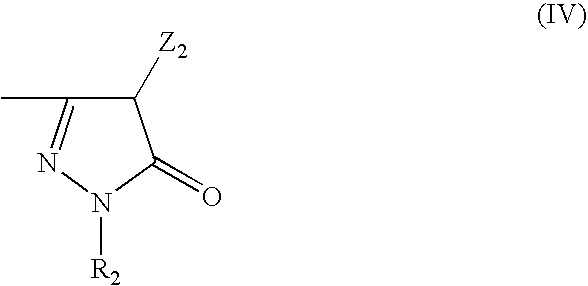Polymer microspheres containing latent colorants and method of preparation
a polymer microsphere and colorant technology, applied in multicolor photographic processing, instruments, papermaking, etc., can solve the problems of inconvenient preparation, high manufacturing cost of techniques, and high cost of spatial addressing methods, so as to achieve enhanced loading of tags, more sensitive arrays, and excessive background noise
- Summary
- Abstract
- Description
- Claims
- Application Information
AI Technical Summary
Benefits of technology
Problems solved by technology
Method used
Image
Examples
example 1
This example illustrates the synthesis method of preparing polymeric microspheres with couplers incorporated in the microspheres.
TABLE 1Synthesis of Polymer Microspheres 1-6:2-methoxyMicroEthanolethanolStyreneCouplerCouplerCouplerPAAsphere #(mL)(mL)(mL)AIB N (g)13 (g)27 (g)41 (g)(g)187.5125.036.60.38——0.853.75*287.5125.036.60.38—0.85 —3.75*387.5125.036.60.380.85 ——3.75*487.5125.036.60.380.4250.425—3.75*543.862.518.30.19—— 0.4251.88*653.1253.1217.90.19——0.851.88**
PAA is polyacrylic acid:
*Mw = 450 K,
**Mw = 90 K, added as 7.52 g of 25% solution in water.
The coupler containing microspheres 1-6 were all prepared by an identical procedure. The coupler or couplers and the 2-2′-azoisobutyronitrile (AIBN) were dissolved in a solution of the styrene and 20 ml of the ethanol and bubble degassed with nitrogen for 20 minutes. The polyacrylic acid (PAA) was dissolved in the remaining solvents in a 3-neck round bottom flask (500 ml for 1-5,250 ml for 5,6) outfitted with a stir bar, reflux c...
example 2
This example illustrates the attachment of pre-synthesized single strand oligonucleotide probe to the surface of coupler incorporated microspheres.
One hundred microliters of coupler incorporated microspheres from EXAMPLE 1 (4% w / v) was rinsed three times in acetate buffer (0.01 M, ph5.0), and combined with one hundred microliters of 20 mM 2-(4-Dimethylcarbomoyl-pyridino)-ethane-1-sulfonate and ten percent of polyethyleneimine. The mixture was agitated at room temperature for one hour and rinsed three times with sodium boric buffer (0.05 M, pH8.3). The microspheres were resuspended in sodium boric buffer.
An oligonucleotide DNA probe with 5′-amino-C6 modification was dissolved in one hundred microliters of sodium boric buffer to a final concentration of 40 nmol. A 20 microliters of cyanuric chloride in acetonitril was added to the DNA probe solution and the total volume was brought up to 250 microtiter using sodium boric buffer. The solution was agitated at room temperature for o...
example 3
This example illustrates the attachment of an antibody bioactive probe to the surface of coupler incorporated microspheres.
One hundred microliters of coupler incorporated microspheres (4% w / v) was rinsed three times in acetate buffer (0.01 M, pH5.0), and combined with one milliliter of 50 mM 2-(4-Dimethylcarbomoyl-pyridino)-ethane-1-sulfonate. The mixture was agitated at room temperature for one hour and rinsed three times with sodium acetate buffer (0.01 M, pH5.0). A goat-anti-mouse IgG of 1 mg was added to the microspheres along with one milliliter of sodium acetate buffer (0.01 M, pH5.0). The mixture was agitated at room temperature for one hour and rinsed three times with 0.01 M phosphate saline buffer pH 7.0. Such antibody modified microspheres are ready for further uses.
PUM
| Property | Measurement | Unit |
|---|---|---|
| diameter | aaaaa | aaaaa |
| diameter | aaaaa | aaaaa |
| diameter | aaaaa | aaaaa |
Abstract
Description
Claims
Application Information
 Login to View More
Login to View More - R&D
- Intellectual Property
- Life Sciences
- Materials
- Tech Scout
- Unparalleled Data Quality
- Higher Quality Content
- 60% Fewer Hallucinations
Browse by: Latest US Patents, China's latest patents, Technical Efficacy Thesaurus, Application Domain, Technology Topic, Popular Technical Reports.
© 2025 PatSnap. All rights reserved.Legal|Privacy policy|Modern Slavery Act Transparency Statement|Sitemap|About US| Contact US: help@patsnap.com



